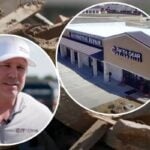As Texas rapidly grows, moves to improve infrastructure could hurt small businesses. What started as a calculated business move in a fast-growing area turned into a major setback for Ricky Jordan, president of Fifth Gear Automotive.
Don’t miss
- I’m 49 years old and have nothing saved for retirement — what should I do? Don’t panic. Here are 6 of the easiest ways you can catch up (and fast)
- Want an extra $1,300,000 when you retire? Dave Ramsey says this 7-step plan ‘works every single time’ to kill debt, get rich in America — and that ‘anyone’ can do it
- Robert Kiyosaki warns of a ‘Greater Depression’ coming to the US — with millions of Americans going poor. But he says these 2 ‘easy-money’ assets will bring in ‘great wealth’. How to get in now
“It really sucks,” he said last month to WFAA after his shop in Argyle, Texas was forced to close and the building was demolished due to a road expansion.
"I’ve lived in this area for 35 years," he said. "This was really an up-and-coming place that needed car repair. There wasn’t a lot here."
He opened Fifth Gear’s second location off U.S. 377 in 2020. “We understood that there was going to be some road expansion that affected the parking lot, so we did a lot of due diligence in the beginning prior to building or buying it to get compliant” said Jordan.
The Texas Department of Transportation (TxDOT)’s long-term infrastructure project plans include widening the highway to four lanes and adding medians, sidewalks, and left-turn lanes.
Jordan said he had no problem working with the county on the affected parking and fire lane issues, but then things took a sudden turn late last year. He said “We had no issues up until we got notification we had to leave.”
What is eminent domain and how can it affect your business?
That notification didn’t come from TxDOT, but from Atmos Energy, a Dallas-based natural gas-only distributor. A spokesperson for the utility company confirmed to WFAA they are required to perform pipeline replacements in accordance with the state’s road expansion project.
“We really didn’t understand we were going to lose the building until the very end. And we didn’t really understand timelines to the very end,” Jordan said. According to him, Atmos said it needed to run gas lines through the land where his shop stood.
To make matters worse, the building was demolished months after his business was told to leave.
Jordan said he was required to vacate the property by January 31, but the building wasn’t demolished until mid-June. He said, “We could have continued operations until they actually needed to tear the building down, that would have saved me months of, at the least, staying in business.”
The upheaval faced by Fifth Gear Automotive is due to a legal mechanism known as eminent domain. It allows the government to take private property for public use, think highways, pipelines, railroads, schools, in exchange for “just compensation.”
“We always prefer to acquire property rights through negotiation,” said Atmos in its statement. “When that is not possible, the courts have a process for acquiring the easement and compensating the landowner.”
That "just compensation" is usually based on fair market value. It may also include certain damages if your remaining property’s market value is diminished by the acquisition itself or by the way the condemning entity will use the property, says the Texas Landowner’s Bill of Rights.
Read more: You don’t have to be a millionaire to gain access to this $1B private real estate fund. In fact, you can get started with as little as $10 — here’s how
It sounds fair, but isn’t always in practice.
For example, in Jordan’s case, the financial and emotional pain may be much deeper than the compensation. "It’s basically cut our business in half and taken us to a point where it’s an investment to stay in business, not a profitable venture," he said.
Negative effects of eminent domain
Here’s how eminent domain works:
- The government identifies the land needed for a project.
- They offer the owner “just compensation.”
- If the owner and the government cannot agree on the value of the property, the government can initiate a legal process called condemnation, filing a claim for the property in court.
Eminent domain is meant to allow the building of better public infrastructure, but for small business owners, it can bulldoze more than just property. When timelines shift or communication is poor, the financial fallout can hit like a wrecking ball.
Fifth Gear Automotive has relocated to a temporary office about two miles away off Highway 407, with hopes of opening a new permanent site there in 2026.
"I’m excited about the investments that we’re making in this area," Jordan said. "We need larger roads and better infrastructure to support a growing city and town, but you need to be very mindful of the businesses and how it impacts the people around."
“By imposing tremendous costs (both social and economic) in the form of lost communities, uprooted families and destroyed small businesses, eminent domain often thwarts, rather than helps, economic growth,” says the Institute for Justice. “Instead of seizing private property, cities can streamline regulatory barriers, like permitting and zoning laws, and usher in development without eminent domain.”
In 2006, the U.S. Government Accountability Office (GAO) produced a report on the use of eminent domain by state and local governments.
Property rights groups and a national community organization described the negative effects like loss of small businesses and jobs, decreases in affordable housing, and the dispersal of communities.
They also said property owners may be hurt by lack of notice, blight designations that negatively impacted neighboring nonblighted properties, significantly undervalued appraisals, and inadequate compensation.
If your business is near a major public works project, talk to a lawyer early, even before the notices arrive.
What to read next
- Financial aid only funds about 27% of US college expenses — but savvy parents are using this 3-minute move to cover 100% of those costs
- Here are the 6 levels of wealth for retirement-age Americans — are you near the top or bottom of the pyramid?
- Here are 5 ‘must have’ items that Americans (almost) always overpay for — and very quickly regret. How many are hurting you?
- How much cash do you plan to keep on hand after you retire? Here are 3 of the biggest reasons you’ll need a substantial stash of savings in retirement
Money doesn’t have to be complicated — sign up for the free Moneywise newsletter for actionable finance tips and news you can use. Join now.
This article provides information only and should not be construed as advice. It is provided without warranty of any kind.







